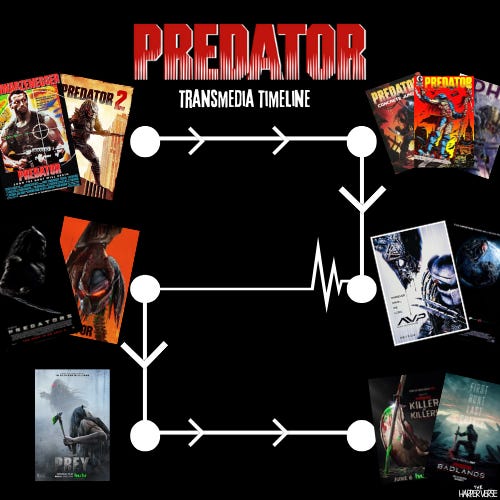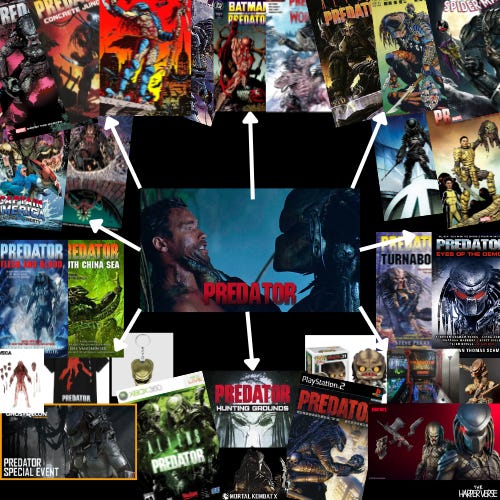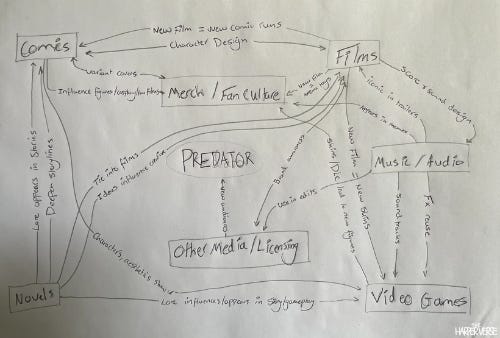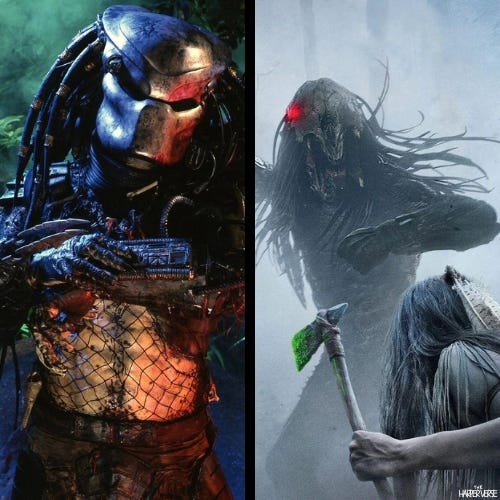Predator, Power, and Platform: A Transmedia Marketing Breakdown
How one of Sci-Fi's most enduring Predators became a multi-media brand - from films and comics to games, toys, and beyond
When we talk about transmedia franchises, Predator doesn’t usually get the same top-tier treatment as Marvel, Star Wars, or even something like The Walking Dead. And yet, here we are in 2025, with not one but two new Predator films being released - one animated, one live-action - and both are receiving active hype and fan engagement.
Not bad, for a franchise that began in 1987 as a sci-fi thriller starring Schwarzenegger, with no obvious sequel potential.
But the Predator franchise has lasted for nearly four decades, morphing and evolving across every major entertainment format. It’s been messy at times (see: The Predator 2018), but it’s also been a case study in how transmedia storytelling works when it’s allowed to expand organically - with a simple core myth, flexible narratives, and a fanbase that keeps showing up.
Let’s break down what Predator has done right, and what lessons it offers for long-term IP thinking in the era of convergence culture.
Predator’s Transmedia Growth: A Timeline
Let’s take a quick tour of the key eras:
1987–1990s: Foundation & Expansion
Predator (1987) launches the myth. Predator 2 (1990) doesn’t quite match the original but sets the stage for larger universe building - most notably, the now-famous shot of a Xenomorph skull in the Predator trophy room.
1990s–2000s: Dark Horse Comics Era
Dark Horse goes wild with Predator and Aliens vs. Predator comics. These stories build a massive mythos, introduce the “honour code” idea more deeply, and eventually lay the groundwork for the AvP films. This is where the Predator expands sideways - into new genres, new worlds, and narrative experimentation.
2004–2007: AvP Crossovers
These were divisive, but culturally massive. For many 2000s kids (including myself), AvP was a gateway to horror-action sci-fi. It was also a key moment in collaboration culture - long before the MCU taught audiences to expect crossover events.
2010s: Stagnation, Then Reboot Attempts
Predators (2010) and The Predator (2018) attempt to reinvigorate the franchise. Results were mixed. But they kept the IP alive - which mattered.
2022: Prey
A game-changer. Prey, a Hulu original by Dan Trachtenberg, re-centers the myth. It strips Predator back to its roots: survival, hunter-vs-hunted, and the tension of “what if this thing landed here and now?” A Comanche warrior vs. a space hunter felt fresh - and it delivered.
2025: Predator Universe Expands Again
This year brings two big entries:
Predator: Killer of Killers (animated, June 6, Hulu)
A time-jumping anthology showing Predator encounters across history. Think: Assassin’s Creed meets The Twilight Zone, but with thermal vision and serrated wrist blades.
Predator: Badlands (live-action, November 7)
In the teaser, Elle Fanning’s character appears to be a synthetic human (or "synth"), because she appears to “reboot” and the Weyland-Yutani logo can be spotted in her eyes - a nod to the Alien universe and a major hint that the two franchises are being connected again.
Why This Franchise Keeps Working
Predator endures not by building a single grand narrative, but by treating each story as a new hunt. That flexible approach to the stories makes it uniquely suited for transmedia - because it resets itself each time, while reinforcing the same mythic pattern.
And here’s the key: Predator isn’t a character. Predator is a role - a being who shows up to test warriors, and then either kills or gets killed. This makes the myth infinitely replayable. The same way Batman is always Gotham’s shadow, the Predator is always the final boss of the ecosystem it invades.
And crucially - each medium has been allowed to do its own thing.
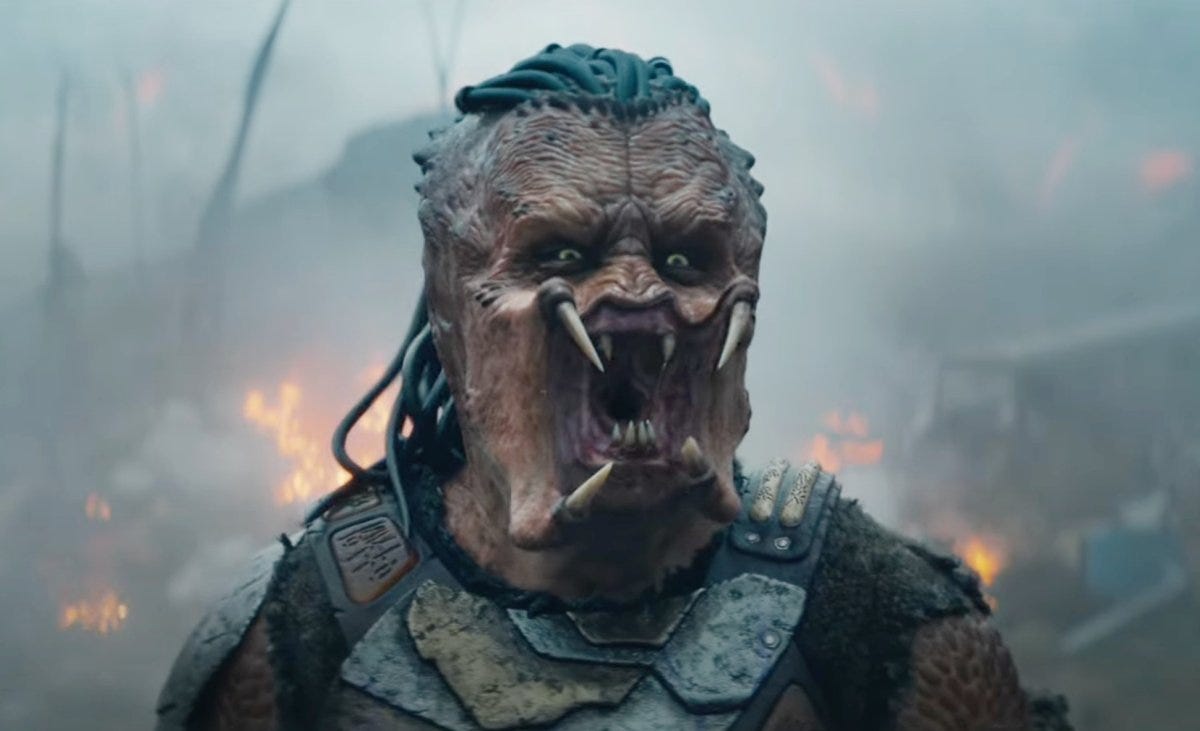
But Predator’s ongoing success isn’t just about genre reinvention or a streak of well-time reboots. What really makes it stand out - and what makes it a case study worth digging into - is how it’s evolved into a transmedia brand universe.
From comics and games to novels, fan culture, and even collectables that feed back into lore, Predator has moved far beyond the screen. And that ecosystem is exactly what we’re going to unpack now - so you best fasten your seat belt, because “traveling through hyperspace ain't like dusting crops, boy!” (ah shit, wrong franchise)
What Makes the Predator Universe a Transmedia Success?
Before I take you through the medium-by-medium breakdown, I want to take a beat to look at what makes Predator work so well as a transmedia case study. Because it really is one - and there are a few standout reasons why this universe has managed to survive (and thrive) across four decades.
🧱 Longevity
Nearly 40 years in the game, and Predator is still evolving - that in itself says something. It’s a brand that’s lasted through massive changes in media consumption, marketing tactics, and pop culture tastes.
🎮 Medium Diversity
It’s not just films. We’ve had comics, novels, video games, toys, merch, crossover events, fan projects, and more. And what’s interesting is that each of these silos hasn’t just recycled the same story - they’ve contributed something new to the world-building. (I’d love to explore these in more detail in future editions, let me know if you’d be interested).
🧬 Genre-Bending
The Predator franchise isn’t locked to one genre - and that flexibility has helped it stay fresh. We’ve seen horror, action, sci-fi, survivalist drama, historical thrillers (Prey), and even superhero crossovers. It’s a flexible IP that plugs into multiple tones and themes.
🧑🚀 Fan Engagement
Crucially, it’s not just the studios doing the work. Fans have kept this world alive: fan films (Predator: Dark Ages), cosplay communities, forums, fanfic, YouTube lore essays. Fans are blurring the line between “official” and “unofficial,” and that participatory culture is a huge part of why Predator still has cultural weight.
But here’s the real kicker - this isn’t just about cool storytelling. What makes Predator so useful as a transmedia case study is how its storytelling and marketing intersect to sustain the brand universe.
Let’s break this down:
The Predator IP has evolved across different media eras - from VHS and arcade cabinets to streaming exclusives and Twitch drops. Its marketing has followed suit, adapting to how audiences consume stories.
The films often act as brand reboots - each one reintroduces or expands core traits of the Predators: their code of honour (Predator 2), off-world hunting (Predators), hybridisation and internal conflict (The Predator). These core pillars act as anchor points.
But it’s the comics that explode the lore. They introduce rival clans, new rituals, female predators, hybrid species, and timelines that stretch far beyond the movies. Crossovers with Aliens, DC, Marvel, Star Wars, and Judge Dredd let the predator species (Yautja) interact with entirely different universes. And many of these stories are now being referenced again in new arcs.
The novels go even deeper - fleshing out inner psychology, introducing new human and Predator characters, and offering that rich internal world-building that’s harder to capture visually. They adapt comics or go completely off-book, giving fans an extended universe feel (think Star Wars Legends territory).
Video games create something entirely different: immersion. From '90s arcade shooters to Predator: Hunting Grounds in 2020, these games let players live in the mythology. AVP-style crossovers blend universes and give us participatory storytelling - environmental world-building where the audience becomes part of the narrative.
Then you have merch, toys, and collectables - with NECA in particular creating action figures that actually build canon. Characters like Scarface or the Elder Predator started as toy designs but came packaged with backstories that plugged into the mythos. That flips the usual transmedia flow: merch feeding canon instead of just responding to it.
And finally, fan culture isn’t just a passive reflection - it’s a creative engine. Fan films, roleplay forums, cosplay subcultures, YouTube lore channels - all of these add depth, stretch the universe in unexpected directions (female Predators, Yautja religion, clan politics), and keep the IP in active rotation even when no film is in sight.
💡 This feels like the right time to introduce a transmedia flywheel - a visual map showing how this IP stretches across media types and where the intersections are occurring.
The Transmedia Flywheel: Predator’s Modular Myth
Here’s how each part of the Predator ecosystem contributes differently to story and marketing:
📡 The Core Pillars of Predator’s Brand Universe
From here, I want to dig into the core pillars - films, comics, games, novels, toys, music, and licensing - and show how each plays a role in the larger Predator ecosystem. We’ll look at storytelling overlaps, audience strategies, and key marketing tactics used to launch and sustain each strand.
This section can be split into seven main sub-sections:
1. 🎬 FILMS: Anchor Medium + Tentpole Marketing
🔥 Marketing Tactics:
Theatrical trailers built on mystery and masculinity (e.g., the 1987 Predator campaign focused on Schwarzenegger, not the alien - the complete opposite to what Badlands is going for - see the original trailer here, it’s crazy).
Back in the day, Predator saw strong cross-promotion in the home entertainment space - bundled VHS releases, DVD box sets, and later Blu-ray reissues tied to sequel launches. I actually work in Home Ents now, and while physical media has mostly faded from the marketing plan, digital ownership is a major focus. These legacy titles still perform when tied to a streaming push or franchise revival - it’s about timing and surfacing that nostalgia at the right moment.
“Prey” (2022) used digital-first, culturally sensitive marketing, including:
Releasing a Comanche-language version.
Highlighting Indigenous representation in press tours.
Targeting streaming-first audiences via Hulu exclusivity.
Remembering that Killer of Killers has also gone straight to Disney+ & Hulu, it means that Disney are strategically placing bets on their content and know where the fans are likely to going to go to watch more from the Predator universe + by skipping cinemas, Disney also saves big on P&A (Print & Advertising).
🧠 Transmedia Overlap:
Films serve as canon pillars - they set the timeline, lore, and tone that other media (like novels or comics) often build on or respond to. Prey, for instance, sparked renewed interest in Predator stories set in historic eras, including some earlier comic arcs.
Each new film revitalises the brand, prompting reprints of comics, NECA figure re-releases (e.g. “Feral Predator”), and new game skins - all coordinated to leverage that tentpole momentum across platforms.
2. 📚 COMICS: World-Building + Fan-Focused Marketing

🔥 Marketing Tactics:
The Predator comics have arguably done the most heavy lifting in building out the extended universe. From the early Dark Horse era to the more recent Marvel takeover (which occurred after Disney acquired Fox), comics have filled in gaps, expanded timelines, and explored alternate takes on the Predator mythos.
They’re where the IP really flexes its creative muscle - we’re talking feudal Japan, World War I, and even Predator vs Batman (more on this in a mo). This is where the Predators don’t just show up - they’re culturally embedded, with their own hierarchies, rituals, and internal codes of honour.
From a marketing pov, comics lean heavily on specialty sales and visual branding. Covers - especially variants - are a whole collectable economy in themselves. This is a space I’m especially interested in because the art is insane sometimes, but also it’s quite extensive (with there usually being multiple renditions of the same comic just with alternate covers - there’s a lot).
Comics, being sold primarily through specialty comic shops or digitally, must lean into that visual culture if they’re to expect any success in being picked up and bought. Some of the recent Marvel runs (like Predator: Black, White & Blood) aim to capitalise on both that same high-contrast, stylised look we see. But, also on the back of other successful series’ such as the same ‘Black, White & Blood/Red’ series we’ve seen other characters like Wolverine, Carnage and Darth Vader feature in - a really cool continuity across IPs.
Then there are crossovers, which are also key marketing levers. As these have often been used to tap into other fandoms, with Predator having squared off against everyone from Batman and Superman to Judge Dredd and Wolverine. These are brand synergies dressed up as narrative events - smart, fan-grabbing stuff.
🧠 Transmedia Overlap:
Comics often act as a testbed for tone and setting - things that might be too risky for film. They’ve also sparked new characters and Predator clans that show up in other media, like figures and games. That makes comics one of the most agile and experimental limbs of the franchise - a real incubator for canon.
3. 🧠 NOVELS: Niche Expansion + Depth Marketing
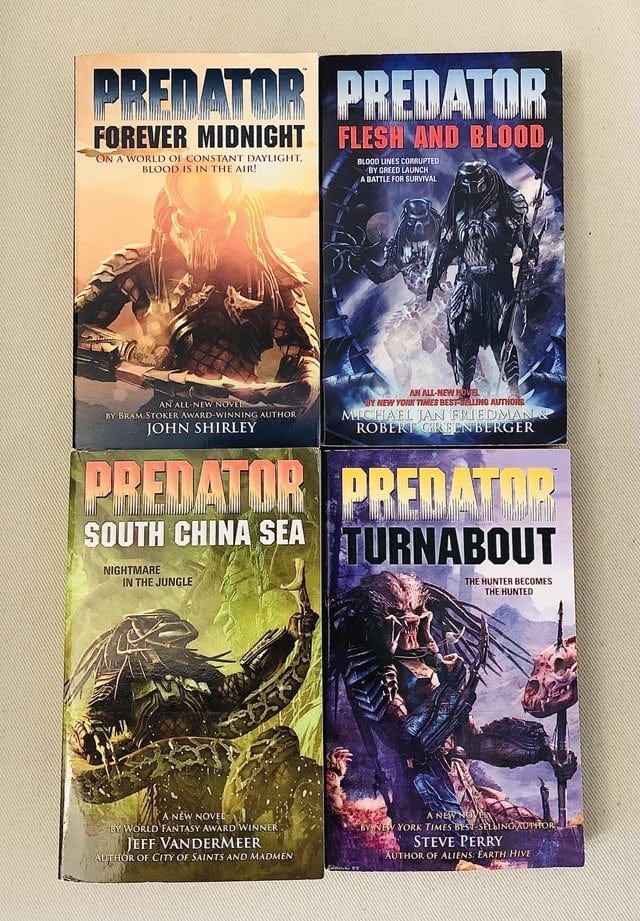
🔥 Marketing Tactics:
The novels are where things get geeky. These stories either adapt comic arcs or venture into totally new territory, introducing fresh human and Predator characters while offering something unique: psychological depth.
This is where we get into a Predator’s head - not just their tactics, but their worldview. What honour means to them. What fear looks like when you’re the apex hunter.
Marketing here tends to be very niche. Most titles are published under sci-fi or military fiction imprints, often launched quietly around key franchise moments - like a game release or a movie anniversary. But even without big ad spends, these books reach the hardcore base, the people who want to live in this universe a little longer, and dig a little deeper.
🧠 Transmedia Overlap:
What’s fascinating is how elements from novels bleed back into the wider canon. Predator clans, internal politics, even specific rituals have shown up in games and comics. The novels offer narrative sprawl and inner life - they flesh out the mythos in a way no other medium quite can.
4. 🎮 VIDEO GAMES: Immersion + Experiential Marketing

If comics are for exploration and novels for introspection, games are for embodiment.
🔥 Marketing Tactics:
From early arcade cabinets in the ‘90s to Predator: Hunting Grounds in 2020, the games have let fans become the Predator - tracking prey, cloaking in trees, switching vision modes. It’s participatory storytelling at its best.
The marketing approach here is very ecosystem-based. Big reveals at events like E3 (I remember how big E3 used to be, sadly they don’t exist anymore & gaming events have become fragmented) and Comic-Con (Alien Earth recently did a pop up at Comic Con London, wish I could’ve gone…), DLC skins referencing other Predator eras (or films), and influencer-driven Twitch content.
I’ve seen first-hand how a Fortnite skin or a Ghost Recon Wildlands crossover can spark renewed interest in the franchise - it makes you wonder how many film viewings are driven by game nostalgia.
🧠 Transmedia Overlap:
Games often synthesise canon, making multiple versions of the Predator (from different media) available in one universe - You might play as the jungle Predator from 1987 in one match, then switch to Scarface from Concrete Jungle the next. While Predators have been confirmed to not be able to time travel, this nonlinear synthesis makes the games a sort of Predator multiverse - unofficially, at least…
5. 🧸 MERCH, TOYS, & FAN CULTURE: Identity + Reverse Canon Marketing
🔥 Marketing Tactics:
This part of the ecosystem is fascinating - because it’s where the line between fan and canon blurs. Companies like NECA create incredibly detailed Predator action figures, which often come complete with backstories printed in the packaging - creating storytelling as a form of product marketing.
Some of these (take “Big Red” from Batman vs Predator for example) have taken on lives of their own, appearing in fan films, comics, and even influencing future designs. It’s reverse canon: merch inspiring lore.
From a marketing standpoint, exclusivity is key.
Comic-Con reveals, limited-edition drops, and premium statues all fuel the collector economy. But what makes this space truly valuable is fan engagement. Cosplay, fan fiction, YouTube breakdowns, lore deep-dives - the community isn’t just watching; they’re building with it.
One of my favourite examples I found in my research is “Blood of the Yautja,” a limited-edition craft beer tied to the franchise. That kind of CPG branding speaks to how deep the culture runs.

🧠 Transmedia Overlap:
Making your brand tangible is the real key takeaway here, because this is the physical arm of the IP - the part you can actually hold, wear, and display. Cosplayers and collectors don’t just watch - they wear the story. They pose it. They bring it to life at conventions and online, where visual language and mythos converge. And in some cases, the fans’ visions loop back into the official narrative.
6. 🎧 MUSIC + SOUND DESIGN: Sonic World-Building
🔥 Marketing Tactics:
This one’s often overlooked, but worth exploring because sound is underrated in franchise marketing and it does a lot more than you realise…
There’s the obvious stuff - Alan Silvestri’s original Predator score, you know the one: that pounding, militaristic rhythm that’s become iconic in itself - but what really sticks with you isn’t always the music. It’s the noise. That sharp, unsettling Predator clicking. The guttural roars. The glitchy thermal vision buzz. These aren’t just sound effects - they’re audio mnemonics (mouthful, I know), little sonic flags that burn themselves into memory.
It’s really interesting how certain sounds can make a brand instantly recognisable. Think of that Go Compare ad from years ago - I grew up recognising and hating that opera dude, just because of that silly song. But that’s the point (sort of). Sonic branding is potent because it’s emotional. Once you connect a noise to a brand, that association is basically permanent - even if you don’t like it.
In Predator’s case, though, it works in their favour. Those audio cues feel like part of the lore. the make the IP feel bigger than just visuals. And from a marketing standpoint, that’s gold - because once your soundscape becomes distinct, it cuts through trailers, fan edits, game menus, and TikToks. It becomes sticky.
🧠 Transmedia Overlap:
The Predator’s audio identity flows naturally across media. That signature click shows up in films, games, fan films, and even merchandise ads - it’s become part of the character’s DNA. Same goes for the soundtrack motifs. Silvestri’s cues have been reuses, remixed, and referenced in follow-up films like Prey, and in licensed games and marketing materials. Sound becomes canon here.
Even beyond official media, the music and FX shows up in UGC (fan edits, cosplay reels, YouTube tributes), and serves as one of the easiest ways to make something feel like Predator. Much like the Disney flywheel model, music and sound help reactivate interest in films whenever there’s a new release or reissue - they tap into that emotional memory bank fans already have, keeping the brand alive even when the IP’s not actively on-screen.
7. 🔗 MEDIA & LICENSING: Marketing-as-Worldbuilding
🔥 Marketing Tactics:
This is where Predator gets a little weird - in the best way. We’re stepping outside the narrative lanes now and into a kind of franchise diplomacy, where Predator shows up in places it technically doesn’t belong… but that’s the point.
These aren’t canon expansions per say. they’re brand partnerships. Whether it’s Predator crashing into Fortnite, squaring off with Sub-Zero in Mortal Kombat X, or making a surprise appearance in Ghost Recon: Wildlands, this is all about cross-pollination. It’s a marketing strategy built on licensing - companies in other industries pay for access to the IP, because it helps them sell more of their product. In return, Predator gets in front of new eyeballs, embedded inside different fanbases. It’s exposure, scaled.
From a business standpoint, this is essentially a dividend. You’re not expanding the story; you're expanding the brand footprint. Arcade machines, mobile games, VR pop-ups, even pinball cabinets - these experiences aren’t random. They’re strategic placements in adjacent entertainment verticals that already have passionate and loyal audiences. And honestly, it’s one of the cleanest ways to monetise legacy IP without needing to build something from scratch.
🧠 Transmedia Overlap:
While these moments don’t directly deepen the Predator mythos, they extend its reach. That crossover skin in Fortnite might be someone’s first encounter with the IP. A fan of Mortal Kombat might find themselves curious about the movies after playing a few rounds as the Predator. In that sense, these cross-industry collisions act soft entry points into the larger franchise ecosystem.
They also create a new type of audience: one that knows Predator not from films or comics, but from moments inside other IPs. And that layered brand awareness - where someone recognises the look, the sound, the vibe of Predator without having ever seen a movie - is incredibly powerful. It turns the franchise into a cultural artifact, floating freely across platforms and genres.
Phew, still with me?
Now that I’ve taken you through the Predator ecosystem as it stands, I bet you’re wondering what the key lessons are to take away from this?
Five Key Lessons for Transmedia Branding (From Predator)
Keep the core myth simple
Predator = ultimate hunter. That clarity lets the brand flex across time periods, genres, formats, and tones.
Let each medium do what it does best
Novels build depth. Games build embodiment. Comics let you get weird. Films sell the fantasy.
Use cross-promotion to build synergy
Timed releases (like Killer of Killers setting up Badlands) show how to ramp up brand engagement across platforms.
Lean into fan culture
Fan films, cosplay, and user-generated stories are extensions of the myth. This isn’t off-brand - it’s brand activation.
Embrace canon fluidity
Not everything has to “count” the same way. Predator thrives on “soft canon.” That’s a strength - it gives creators room to experiment, while still feeding the overall mythology.
Where the Universe Is Going (And Why It’s Working)
"Both Killer of Killers and Badlands make that universe SO MUCH bigger."
- Dan Trachtenberg (Reddit AMA, 2025)
The fact that Killer of Killers has a post-credits scene showing the lead from Prey frozen in stasis? That’s not just cool - it’s intentional franchise linkage. It’s what Marvel does with Nick Fury. It tells fans: “we’re building toward something bigger.”
Rumours that Arnold might return? Elle Fanning being a Weyland-Yutani synth? That AvP 3 could actually happen?
This is how momentum builds in a fan-driven universe. You don’t just drop sequels - you plant seeds and let the fandom theorise, remix, and build hype on your behalf.
Quotes That Say It All
From The Direct’s interview with Joshua Wassung, co-director of Killer of Killers:
“We really wanted the fans to decide where each of those crazy skeletons came from… there are all kinds of fun possibilities.”
And another from Direct:
“Predator: Badlands is a huge movie. So Dan [Trachtenberg] is toiling away… I can tell you, he was at the screening and literally went back to work.”
From Dan Trachtenberg on designing IP-infused but story-first films:
“The key has been thinking of stories that would be incredibly intense and interesting even if there were no ‘IP’ involved. But when you add the franchise elements, that story is EVEN BETTER.”
Final Thought: Predator as a Transmedia Case Study
The Predator franchise doesn’t always get the credit it deserves. But it’s a blueprint for how to build, evolve, and reignite a transmedia IP - without always needing a mega-budget or cinematic universe map.
It respects its core myth. It lets different media forms explore the edges. It leans into fandom. And it understands that sometimes, the hunt is more important than the outcome.
And with 2025’s films, it looks like the next phase of that hunt has just begun.



